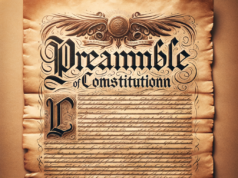Table of Contents
- 1 Understanding Federalism: A Framework for Governance in the United States
- 2 Historical Context: The Evolution of Federalism and Its Key Milestones
- 3 The Balance of Power: State vs. Federal Authority in Contemporary Issues
- 4 Economic Disparities: How Federalism Influences Regional Inequalities
- 5 Social Justice and Federalism: Navigating Civil Rights Across States
- 6 The Future of Federalism: Challenges and Opportunities in a Changing Landscape

Federalism, a system of governance that divides power between a central authority and constituent political units, is a defining feature of the United States. As the nation grapples with complex social, economic, and political challenges, the tensions inherent in this framework have come to the forefront. This article explores the multifaceted nature of federalism, its historical evolution, the balance of power between state and federal authorities, economic disparities influenced by this system, the intersection of social justice and civil rights, and the future of federalism in an ever-changing landscape.
Understanding Federalism: A Framework for Governance in the United States
Federalism is a unique governance structure that allows for the coexistence of national and state governments, each with its own set of powers and responsibilities. In the United States, this framework is enshrined in the Constitution, which delineates the powers of the federal government while reserving other powers for the states. This dual system is designed to promote local governance and ensure that diverse regional interests are represented, fostering a balance that can accommodate a wide array of political, social, and economic perspectives. However, the complexity of federalism also leads to tensions, as states and the federal government often find themselves at odds over jurisdiction, policy implementation, and resource allocation.
Historical Context: The Evolution of Federalism and Its Key Milestones
The evolution of federalism in the United States can be traced back to the founding of the nation, with the Federalist Papers advocating for a strong central government while addressing fears of tyranny. Key milestones in this evolution include the ratification of the Constitution in 1788, the Civil War and Reconstruction era, which redefined the relationship between state and federal authorities, and the New Deal, which expanded federal power in response to the Great Depression. Each of these periods marked significant shifts in the balance of power, reflecting the ongoing struggle to define the limits and responsibilities of both state and federal governments. As society has evolved, so too has the interpretation of federalism, influenced by landmark Supreme Court decisions and legislative actions that have shaped the landscape of American governance.
The Balance of Power: State vs. Federal Authority in Contemporary Issues
In contemporary America, the balance of power between state and federal authorities remains a contentious issue, particularly in areas such as healthcare, education, and environmental regulation. States often seek to assert their authority in response to federal mandates, leading to a patchwork of laws and regulations that can create confusion and inequality. For instance, debates over healthcare policy have seen states challenge federal initiatives, such as the Affordable Care Act, while environmental regulations have prompted states to adopt more stringent measures than those imposed at the federal level. This dynamic interplay raises critical questions about the efficacy of federalism in addressing pressing national issues and the extent to which states can act independently of federal oversight.
Economic Disparities: How Federalism Influences Regional Inequalities
Federalism also plays a significant role in shaping economic disparities across the United States. The allocation of federal funds, tax policies, and regulatory frameworks can disproportionately benefit certain states or regions, exacerbating existing inequalities. For example, states with more robust economies often have greater access to federal resources, while those struggling economically may find themselves at a disadvantage. Additionally, the ability of states to set their own tax rates and economic policies can lead to competition among states, resulting in a “race to the bottom” where states lower standards to attract businesses. This uneven distribution of resources and opportunities highlights the complexities of federalism and its impact on regional economic health.
The intersection of federalism and social justice is particularly pronounced in the realm of civil rights. While the federal government has historically played a crucial role in advancing civil rights legislation, states have often resisted or undermined these efforts. Issues such as voting rights, police reform, and LGBTQ+ protections illustrate the challenges of navigating civil rights within a federalist system. For instance, states have varying laws regarding voter ID requirements and access to the ballot, leading to disparities in voter participation and representation. The ongoing struggle for social justice underscores the need for a more cohesive approach to civil rights that transcends state boundaries while respecting the autonomy of individual states.
The Future of Federalism: Challenges and Opportunities in a Changing Landscape
As the United States faces an increasingly polarized political climate and rapid societal changes, the future of federalism presents both challenges and opportunities. The rise of populism and partisanship has led to heightened tensions between state and federal authorities, with issues such as immigration, public health, and climate change becoming flashpoints for conflict. However, these challenges also present opportunities for innovation and collaboration, as states experiment with policies that address local needs while contributing to national solutions. The ongoing dialogue about the role of federalism in American governance will be crucial in shaping a more equitable and effective system that can respond to the complexities of the 21st century.
In conclusion, federalism remains a vital and dynamic framework for governance in the United States, characterized by its inherent tensions and complexities. As the nation navigates contemporary challenges, understanding the historical context, the balance of power, economic disparities, social justice issues, and the future of federalism is essential for fostering a more equitable and responsive governance structure. The ongoing evolution of federalism will undoubtedly shape the trajectory of American society, making it imperative for citizens and policymakers alike to engage in meaningful dialogue about its implications for the nation’s future.
























